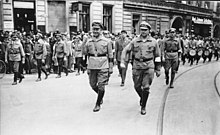Willy Leow
Willy Leow | |
|---|---|
 Leow (right) marching alongside Ernst Thälmann | |
| Member of the Reichstag | |
| In office 1928–1933 | |
| Personal details | |
| Born | January 25, 1887 Brandenburg an der Havel, German Empire |
| Died | October 3, 1937 (aged 50) Soviet Union |
| Political party | Communist Party of Germany (1919-) Independent Social Democratic Party of Germany (1917-1919) Social Democratic Party of Germany (1904-1916) |
Willy Leow (25 January 1887 – 3 October 1937) was a German communist politician and activist.
Life and work
Willy Leow attended elementary school in Brandenburg an der Havel. Then he learned the carpentry trade and was taught at the Workers' Educational School in
1925 Leow was elected the Second Chairman of the Roter Frontkämpferbund (RFB), founded in 1924, the defense and protection organization of the KPD. Leow was often seen marching alongside other prominent KPD and RFB activists such as Ernst Thälmann. 1928 Leow was elected to the Reichstag, where he remained until 1933. Later SPD politician Herbert Wehner, who was himself a communist in the Weimar period wrote decades later in his memoirs, Leow was "a thoroughly corrupt person".[1]
After the
Post mortem
In the history of the
References
- ^ Herbert Wehner: Zeugnis, 1982, S. 79.
- ^ Ulla Plener, Natalia Mussienko (Hrsg): Verurteilt zur Höchststrafe: Tod durch Erschießen. Todesopfer aus Deutschland und deutscher Nationalität im Großen Terror in der Sowjetunion 1937/1938. Reihe: Texte/Rosa-Luxemburg-Stiftung, Bd. 27. Dietz, Berlin. 2006. S. 58
- ^ Walter Hütter: Bilder die Lügen. Begleitbuch zur Ausstellung der Stiftung Haus der Geschichte der Bundesrepublik Deutschland, Bonn 2000.
Literature
- Leow, Willy. Bundesstifung Aufarbeitung Berlin
